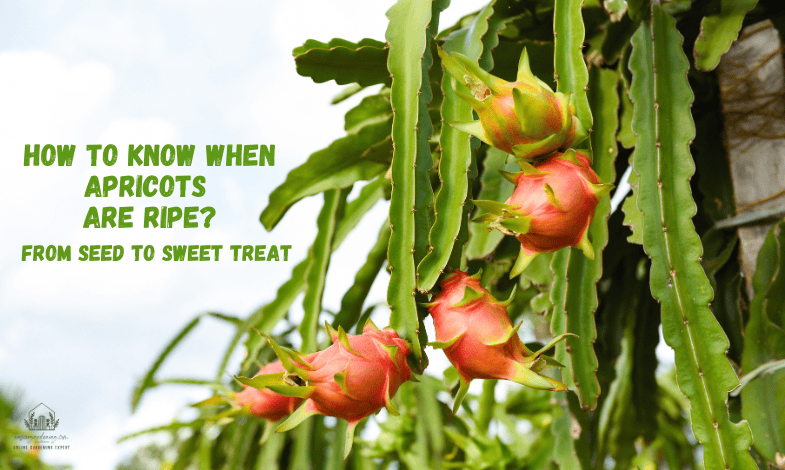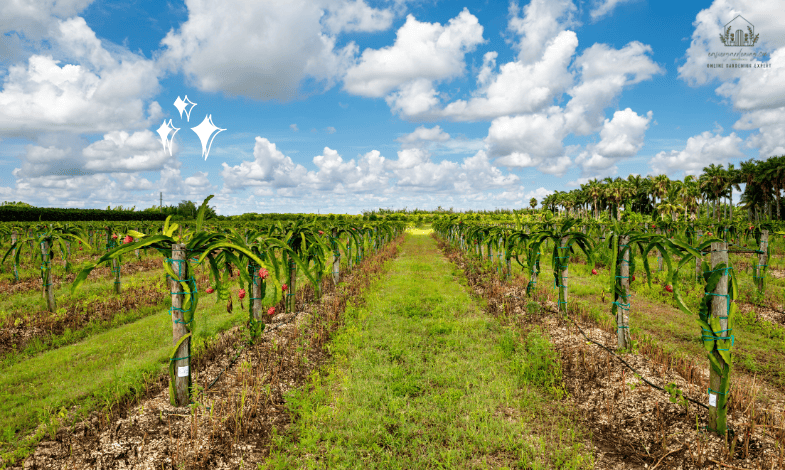Ah, dragon fruit, that Instagram-worthy, pink-scaled wonder that looks like it was plucked straight from a fantasy novel! But here’s the million-dollar question: How long does it take to go from a tiny seed to that show-stopping fruit? Well, buckle up, fruit fans, because we’re about to embark on a time-traveling adventure through the life of a dragon fruit plant!
Did you know that some commercial dragon fruit farms in Vietnam have reported harvesting fruits just 1.5 years after planting? Now that’s what I call fast food! But before you start clearing out your backyard for a dragon fruit empire, let’s dive into the juicy details of this exotic fruit’s growth journey. Get ready to discover why patience is a virtue when growing these delicious, spiky spheres of sweetness!
Contents
- Planting Dragon Fruit
- Getting Those Seeds to Sprout
- When Can You Expect Fruit?
- Growing from Seeds
- Seed Germination Timeline
- Reaching Reproductive Stage
- Growing from Cuttings
- Faster Fruit Production
- Factors Affecting Growth
- Ideal Growing Conditions
- Temperature and Sunlight
- Soil and Drainage
- Getting Your Dragon Fruit to Bloom
- Snip and Bloom
- Boosting Blooms
- Care and Patience
- Rooting Process
- Fruit-Bearing Duration
- Conclusion
Planting Dragon Fruit
Growing dragon fruit can be a blast for gardening fans. Here, we’ll break down how to get those seeds sprouting and how long it takes before you can munch on your dragon fruit.
Getting Those Seeds to Sprout
Starting with seeds is like watching magic happen, but it takes patience. Dragon fruit seeds usually take about 30 days to sprout (CABI). Keep things warm and humid for the best results.
- Prep the Seeds: Grab a ripe dragon fruit, scoop out the seeds, rinse them well, and dry them on a paper towel.
- Planting: Sprinkle the seeds on top of some well-draining soil. Cover them lightly with a thin layer of soil.
- Watering: Keep the soil moist but not soggy. A spray bottle works great for this.
- Light: Give them direct sunlight or use grow lights to ensure they get enough light.
Patience is critical here; germination can take its sweet time.
When Can You Expect Fruit?
After the seeds sprout, the little plants start their journey to fruit production. It usually takes about 6 to 12 months for dragon fruit plants to bear fruit.
| Growth Stage | Timeline |
|---|---|
| Seed Germination | 30 days |
| Fruit Production | 6-12 months |
If you use cuttings instead of seeds, you might get fruit within a year, sometimes even faster. Once mature, each plant can give you around 20–30 fruits a year.
For more tips, check out our articles on keeping dragon fruit fresh and telling if dragon fruit is pink or white.
Growing dragon fruit takes time and effort, but biting into your home-grown fruit makes it all worth it.
Growing from Seeds
Growing dragon fruit from seeds requires patience and dedication. Let’s break down the timeline for seed germination and the journey to fruit-bearing.
Seed Germination Timeline
Dragon fruit seeds usually take around 30 days to sprout. You must ensure the seeds get enough moisture, warmth, and light during this time.
Here’s a simple timeline for seed germination:
| Stage | Timeframe |
|---|---|
| Seed Planting | Day 0 |
| Initial Sprouting | Day 7-14 |
| Full Germination | Day 30 |
For more detailed planting tips, check out our guide on how to plant creeping thyme seeds.
Reaching Reproductive Stage
Once the seeds sprout, the dragon fruit plant enters the vegetative growth phase. This is when stems and branches develop, setting the stage for future fruit. It takes about five years for a dragon fruit plant to grow from seeds to produce flowers and fruit.
| Stage | Timeframe |
|---|---|
| Vegetative Growth | 1-5 Years |
| Reproductive Stage | 5 Years |
During these years, keeping the plant in ideal conditions is vital. For more tips, check out our section on ideal growing conditions for dragon fruit.
By understanding these timelines and giving your plant the care it needs, you can successfully grow dragon fruit from seeds and enjoy the fruits of your labor. For more gardening tips, visit our articles on how to grow mandarin orange seeds and how long does it take for basil to germinate.
Growing from Cuttings
Growing dragon fruit from cuttings is a favorite for many gardeners because it’s quicker and more efficient. Let’s break it down.
Faster Fruit Production
Using cuttings to grow dragon fruit can save you a lot of time. Plants grown from cuttings can start flowering and producing fruit within 1 to 2 years. That’s way faster than the 3-4 years it takes for seed-grown plants to bear fruit.
| Method | Time to Fruit Production |
|---|---|
| From Seeds | 3-4 years |
| From Cuttings | 1-2 years |
Each dragon fruit plant can produce around 20-30 fruits annually once they start bearing fruit. But don’t get too excited just yet—cuttings might still take 6 to 14 months to bear fruit after rooting.
Factors Affecting Growth
Several things can influence how well your dragon fruit cuttings grow and produce fruit. Knowing these can help you give your plants the best care.
- Environment: Dragon fruit cuttings love warm, sunny spots. They need plenty of sunlight to grow and produce fruit.
- Soil: Well-draining, sandy soil is essential to prevent root rot. Overwatering or poor drainage can harm your plant. Make sure the soil is airy and drains quickly.
- Planting Depth: Plant the cuttings about 2 to 3 inches deep in the soil to allow proper rooting.
- Rooting Process: Dragon fruit plants have shallow, delicate roots that grow close to the soil surface and deeper before fruiting. These thin roots emerge from the plant’s stems and help the plant attach to supports without parasitism.
- Watering: While dragon fruit plants need regular watering, avoid over-watering. Keep the soil moist but not waterlogged to prevent root rot.
For more tips, check out our articles on how to keep dragon fruit fresh and how to tell if dragon fruit is pink or white.
Ideal Growing Conditions
So, you’re ready to grow some dragon fruit, huh? Let’s make sure you get it right. The secret sauce? Temperature, sunlight, soil, and drainage. Nail these, and you’ll munch on homegrown dragon fruit quickly.
Temperature and Sunlight
Dragon fruit loves basking in the sun. Think of it as a sunbather on a tropical beach. It thrives best in temperatures between 65-80°F (18-30°C). If you live in a subtropical area, it can even handle a bit of chill, just above freezing. But don’t push it—keep it warm and sunny.
| Growing Condition | Ideal Range |
|---|---|
| Temperature | 65-80°F (18-30°C) |
| Sunlight | Full sun, no shade |
Have you got a sunny spot in your backyard or balcony? Perfect. Your dragon fruit will thank you with vibrant growth and juicy fruit. For more green thumb tips, check out our guide on how to grow perennial flowers from seeds.
Soil and Drainage
Dragon fruit isn’t too fussy about soil, but it does have a type: well-draining, sandy soil. Think desert vibes. Good drainage is necessary, whether planting in pots or straight into the ground. Over-watering is a big no-no—it can lead to root rot, and nobody wants that. When planting cuttings, stick them about 2 to 3 inches into the soil. This gives them a good start.
| Soil Condition | Requirement |
|---|---|
| Soil Type | Well-draining, sandy |
| Planting Depth | 2-3 inches |
Get the temperature, sunlight, soil, and drainage right, and you’ll have a happy dragon fruit plant. Want more gardening wisdom? Dive into our articles on how to grow mandarin orange seeds and keep dragon fruit fresh. Happy planting!
Getting Your Dragon Fruit to Bloom
Growing dragon fruit takes some patience and a bit of know-how. If you want those vibrant flowers and tasty fruits, there are a few tricks to help your plant.
Snip and Bloom
Making small cuts on its stems is one nifty trick to getting your dragon fruit plant to flower. Sounds weird, right? But it works! Just grab a sharp, clean tool and make a few small cuts about 3 inches from the tips of the stems. Do this in late winter when the plant is gearing up for the growing season. This little snip encourages the plant to heal and, in the process, produce flowers.
| Snip and Bloom | Details |
|---|---|
| Best Time | Late winter |
| Cut Location | 3 inches from the tips |
| Plant Age | 5 years old |
Make sure your tool is clean to avoid any nasty infections. This method helps the plant focus its energy on flowering rather than growing more stems.
Boosting Blooms
Other than snipping, there are different ways to coax your dragonfruit into blooming. Sunlight is a biggie. These plants love warm, sunny spots and need well-draining, sandy soil to thrive. Too much water can cause root rot, so let the soil dry out between waterings.
Here are some tips to help your dragon fruit bloom:
- Water Wisely: Keep the soil moist but dry it between waterings.
- Feed Right: Use a balanced fertilizer to keep the plant healthy and ready to flower.
- Prune Regularly: Trim off dead or damaged stems to encourage new growth.
- Support System: Give the plant something to climb on. Dragon fruit plants are climbers and need support.
| Bloom Boosters | Details |
|---|---|
| Sunlight | Warm, sunny spots |
| Soil | Well-draining, sandy soil |
| Watering | Let the soil dry out between waterings |
| Fertilizer | Balanced for growth and flowers |
| Pruning | Trim dead or damaged stems |
| Support | Provide a structure for climbing |
By following these tips and giving your plant the proper care, you’ll be well on your way to enjoying those beautiful dragon fruit blooms. For more tips on dragon fruit care, check out our articles on how to tell if dragon fruit is pink or white and how to keep dragon fruit fresh.
Care and Patience
Growing dragon fruit isn’t just a hobby; it’s a commitment. Let’s break down the rooting process and the time these exotic plants take to produce those juicy fruits.
Rooting Process
Dragon fruit plants have shallow, delicate roots that grow close to the soil surface, extending 20-30 cm and more profound (45-63 cm) before fruiting. These thin roots emerge from the plant’s stems and are epiphytic, helping the plant attach to supports without parasitism.
To ensure successful rooting:
- Environment: Place the cuttings in a warm, sunny spot.
- Soil: Use well-draining, sandy soil to keep rot at bay.
- Planting Depth: Stick the cuttings about 2 to 3 inches into the soil.
- Watering: Don’t drown them. Keep the soil moist, not soggy.
| Stage | Depth (cm) | Condition |
|---|---|---|
| Initial Rooting | 20-30 | Shallow, delicate roots |
| Pre-Fruiting | 45-63 | Deeper roots |
Fruit-Bearing Duration
The time it takes for a dragon fruit plant to bear fruit can vary depending on whether it’s grown from seeds or cuttings and how much care it receives.
- From Seeds: If you’re starting from seeds, be prepared to wait up to five years for fruit. It’s a long haul, but the payoff can be sweet.
- From Cuttings: Cuttings are quicker, usually taking 6 to 14 months post-rooting to start bearing fruit. The timeline can vary based on climate, the health of the cutting, and how well you care for it.
| Method | Time to Fruit | Notes |
|---|---|---|
| Seeds | Up to 5 years | It requires patience and consistent care |
| Cuttings | 6 to 14 months | Faster but still needs proper care |
Providing appropriate care during this period is crucial to ensure healthy growth. Regularly check the soil moisture, provide adequate sunlight, and support the plant’s growth. For more insights on growing dragon fruit and other plants, explore our articles on how to grow perennial flowers from seeds and how to grow mandarin orange seeds.
Conclusion
And there you have it, folks—the epic saga of dragon fruit growth, from tiny seed to tantalizing treat! While it might not be an overnight success story, the journey of growing dragon fruit is filled with excitement, surprises, and sweet rewards. Remember, whether it takes 1.5 years or 3, each dragon fruit plant is on its unique timeline.
Whether you’re planning to grow a single plant on your balcony or dreaming of a dragon fruit dynasty, you’re now armed with the knowledge to nurture these fantastic fruits. So plant those seeds, and may your future be filled with vibrant, delicious dragon fruits. Happy growing, and don’t forget to take plenty of pics for the ‘gram when harvest time rolls around!



